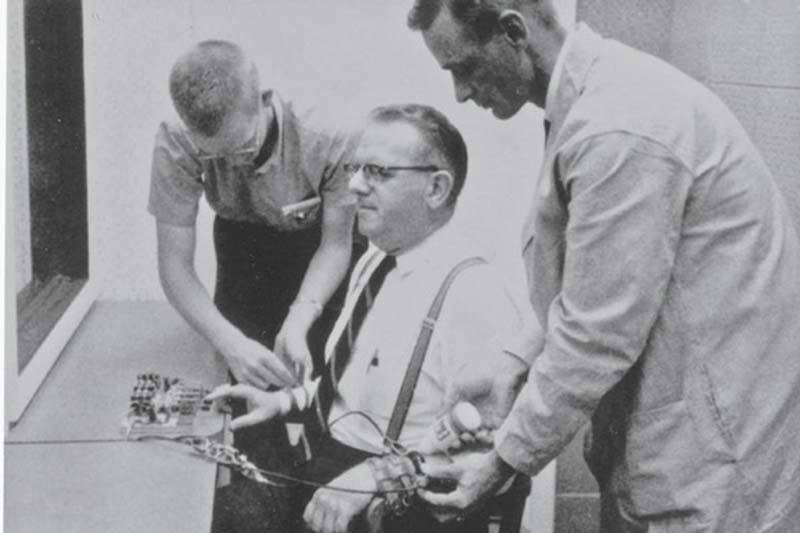For the record, the writers at All That Is Interesting are not anti-science. For every person that scientific research hurts, hundreds are saved from pain and disease.
But, sometimes, a scientific experiment is so obscenely brutal that you have to wonder if it was really worth it. Here are some of the most terrifying, manipulative experiments ever conducted in the name of science:
The Milgram Obedience Experiments

An actor is connected to a device that delivers “electric shocks”. Source: American Psychological Association
Are you truly an independent thinker? Do you consider yourself to be an iconoclast, living by your own standards as opposed to being guided by the signals and expectations of others? Don’t be so sure. The Milgram Obedience Experiment basically showed how much we listen to people if they’re wearing a white coat.
“The experiment requires that you continue.” That’s what participants were told by psychologist Stanley Milgram after they pushed a button that would electrically shock a “subject” in the other room.
In actuality, the “subject” was an actor, and no electricity flowed through the wires. The actor would flail, scream and beg the participant not to continue, but a researcher in a white coat would ask him to turn up the voltage, informing him that “the experiment requires that (he) continue”.

The setup of the Milgram obedience experiment: an actor in another room responds to shocks delivered by the “subject”. Source: American Psychological Association
Later, the researcher would say, “you have no other choice but to continue”. Eventually, as the voltage was “increased”, the actor would stop moving altogether.
You think you would have stopped as soon as you had caused another person pain, right? You’d be wrong— 65% of participants kept going even after the recipient of the shocks thrashed in agony and appeared to be stone dead.
The Stanford Prison Experiment

The Stanford Prison Experiment, as re-enacted by Polish artist Artur Zmijewski.
Are you free from the burden of ego? Do you think you would act appropriately if given power over another person? The Stanford Prison Experiment, conducted by psychologist Philip Zimbardo, tested just that question.
A group of test subjects was randomly divided into “guards” and “prisoners”. Participants were given $15 a day ($87 a day in 2015 dollars) to live out the experience of being a prisoner or a guard as realistically as possible. “Inmates” were abducted from their homes, strip searched, and given new identities. “Guards” were given wooden batons and told not to physically hurt the inmates, but to make their lives as arbitrary and powerless as possible.
http://www.youtube.com/watch?v=RpDVFp3FM_4
“We’re going to take away their individuality in various ways”, Zimbardo would say to the randomly-selected guards. And so the guards did, forcing inmates to stand naked for hours on end, relieve themselves in a bucket, and sleep on the bare concrete. After just 36 hours, an inmate (known only as #8612) began to scream and rant, and had to be removed from the study.
The study only lasted six days, and one-third of the “prison guards” were found to display “genuinely sadistic behavior”. It took less than one week to turn a totally normal person into a sadist, or to strip him of his identity and dehumanize him altogether.
Harlow’s Isolation Experiments

Harry Harlow poses with a “surrogate mother” doll. Source: LIFE Magazine
Harry Harlow was a behavioral psychologist who specialized in performing mind-bendingly depressing experiments on rhesus macaques. Harlow is quoted as saying “I despise cats. I hate dogs. How could you like monkeys?” Judging by his sordid past, it’s possible that these sentiments extended to people.

Figures from Harlow’s experiments in child isolation. Source: H. Harlow
One of his experiments in child development was called “The Child Isolation Experiment”, in which baby monkeys would be torn from their mothers at an early age to see what became of their development.
In some cases, infant monkeys were given a monkey doll to act as a sort of “security blanket”, but all monkeys involved would suffer from crippling emotional and physical problems, including poor digestion and lower weights.
Harlow’s “Pit Of Despair”

Harlow’s Pit Of Despair apparatus, designed to instill a sense of hopelessness in rhesus macaques.
Harry Harlow gets two entries on this list, and this next experiment takes the sadistic, terrifying cake.
Harlow was known for his “flowery” descriptions of his experiments: he lovingly referred to his forced-mating table as his “Rape Rack”, for example. But the darkest and most terrifying of all Harlow’s experiments was likely the “Pit of Despair”.

A monkey, clinging desperately to a “surrogate mother” doll. Source: LIFE Magazine
The Pit of Despair was, well, a steel pit in which Harlow would place monkeys until they went insane with hopeless depression, just to see what would happen. Separating three month to three year old monkeys from their mothers, Harlow placed the macaques in the Pit Of Despair for almost three months at a time. The resulting animals would barely eat or move, instead resigning themselves to hopeless cowering at the corner of the cell.
Later, these monkeys would be forced to mate (see “Rape Rack” above) and foster children, which the scarred monkeys would mistreat horrendously. Harlow would say of these damaged monkey parents: “Not even in our most devious dreams could we have designed a surrogate as evil as these real monkey mothers were”. So, if your veterinarian is named Harlow, get a new veterinarian.
Britches at UC Riverside
Britches the monkey is a prime example of the cost of so-called progress. (WARNING: The following image is nightmare-inducing.)

Britches, who was not born blind, made blind. Source: PETA
At face value, the cause was noble–researchers needed access to blinded monkeys so they could test out a brain-implanted sonar device that would improve the lives of patients without sight. Some non-sighted people like Ben Underwood have impressively developed a sort of echolocation, clicking their tongue to map their surroundings.
The transcranial device tested on Britches the monkey was designed in the hopes of giving that gift of echolocation to blind patients everywhere. The trouble was, Britches was not blind. Scientists had to make him blind to test their product, and they did so by sewing his healthy eyes shut.
Project MKULTRA
Do you think your mind is impervious? It might be a bit more flexible than you think. Project MKULTRA is a go-to topic for any conspiracy theorist worth his salt, but here’s what we know for sure: CIA psychologists in the 50s decided it would be worthwhile to try to earn complete control over a person’s willpower.
Using LSD, electroshock therapy, recorded tapes that were sometimes played over 500,000 times and more, the American government tried its best to induce a “behavioral modification” (read: amnesia and suggestibility) in people.
Experimenters went as far as to dose unsuspecting citizens and even children with LSD. Most of the files on MKULTRA were destroyed in the wake of the Watergate scandal, but its legend lives on as another one of America’s creepy, manipulative foul-ups.
Tuskegee

Smiling while he watches you die from a disfiguring disease. Source: National Archives
The creepy, manipulative foul-up that takes the cake, however, is the Tuskegee Syphilis Study. The US Public Health Service studied syphilis by infecting unwilling and unaware black male sharecroppers with the disease.
For forty years.
From 1932 to 1972, the American government infected and subsequently neglected to treat these men, instead lying to them and saying they were receiving “free health care”. In total, hundreds of men died, and 19 children were born with congenital syphilis as a result.

A bust displaying the effects of long-term, untreated syphilis.
Congenital syphilis is a brutal, unfair disease (congenital, in this case, means “at birth”). Children born with it are often deaf, their livers already failing from being too large, their poorly-developed brains afflicted with seizures.
Even in the time of the Tuskegee experiments, the cure for syphilis existed: simple penicillin. Of course, though, the people of Tuskegee received no such treatment.
Next, read about the most bizarre ocean creatures in the world and like All That Is Interesting on Facebook! Then, read up on ten fringe sciences that are as fascinating as they are terrifying.






